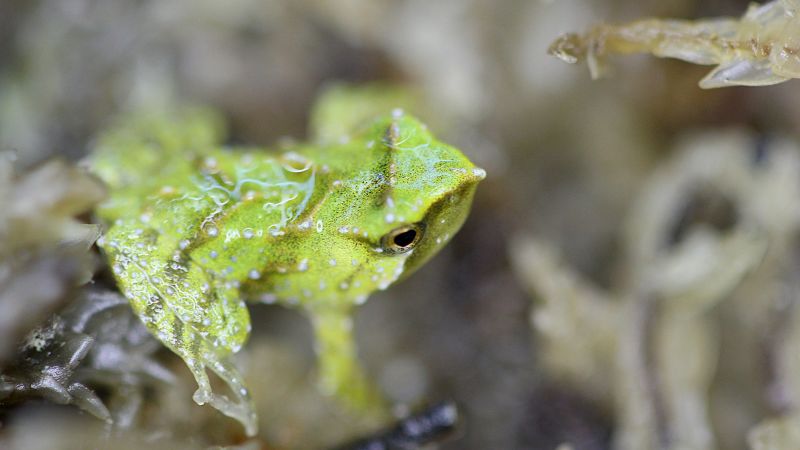In recent conservation efforts, 11 endangered male frogs, known as Darwin’s frogs, have embarked on a remarkable journey of 7,000 miles (11,000 kilometers) to secure the survival of their species. These frogs, now thriving at London Zoo, have recently “given birth” to 33 healthy froglets, marking a significant achievement in amphibian conservation.
The origin of the Darwin’s frogs traces back to Parque Tantauco, a secluded area located on an island off the coast of Chile. These amphibians face severe endangerment largely due to a lethal fungus that threatens their existence. To protect these frogs from the looming extinction caused by this pathogen, conservationists made the decision to transport them to London Zoo, a halfway point across the globe that provides a safer environment away from the deadly chytrid fungus.
Notably, Darwin’s frogs exhibit a unique reproductive behavior uncommon in the amphibian world: male frogs carry their developing tadpoles in their vocal sacs. This specialized adaptation allows them to safeguard the tadpoles until they undergo metamorphosis into froglets. Afterwards, these attentive fathers progressively “spit out” the froglets, which is generally a batch of three to seven, as per the insights provided by National Geographic.
Even in adulthood, Darwin’s frogs are remarkably small creatures, with a weight of under two grams (0.07 ounces) and a size measuring less than three centimeters (1.18 inches). This diminutive size complicates the task for conservationists to locate these frogs in their natural forest habitats.
The lush and dense forests of Parque Tantauco, once an ideal ecosystem for these frogs, have been severely compromised by the chytrid fungus. This disease has wreaked havoc on amphibian populations worldwide. To ensure the survival of this vulnerable species, in October 2024, conservationists relocated 52 healthy frogs to London, where they could reproduce without the threat posed by the deadly fungus.
The transportation process for these frogs to London was extensive and complex. Their journey began with a six-hour boat ride to the mainland, followed by a 15-hour long drive to Santiago, the capital of Chile. Finally, the frogs concluded their travel with a 14-hour flight to Heathrow Airport, all the while secured in specially designed, climate-controlled boxes to ensure their safety during transit, as reported by the London Zoo.
The successful arrival of 33 froglets at the zoo has been hailed as a “landmark moment” in the conservation of Darwin’s frogs by Ben Tapley, the curator of amphibians at London Zoo. He emphasized that the successful rearing of these froglets represents not just hope for this particular species but also underscores the importance of collaborative efforts within the conservation community. It serves as a crucial reminder of the vital role that zoos play in conservation efforts worldwide.
Looking ahead, conservationists are hopeful that through continued efforts, the flourishing population of Darwin’s frogs can ultimately be reintroduced to their native habitats in Chile once the threat posed by the chytrid fungus is adequately addressed. This ambitious endeavor highlights the profound impact of dedicated conservation strategies on the fate of endangered species, as collaboration and ceaseless determination are key in combating the issues that threaten biodiversity.
The journey of these frogs and their successful breeding serves as an inspiring narrative in the realm of wildlife preservation and offers a glimmer of optimism for the survival of different species grappling with extinction challenges worldwide.



